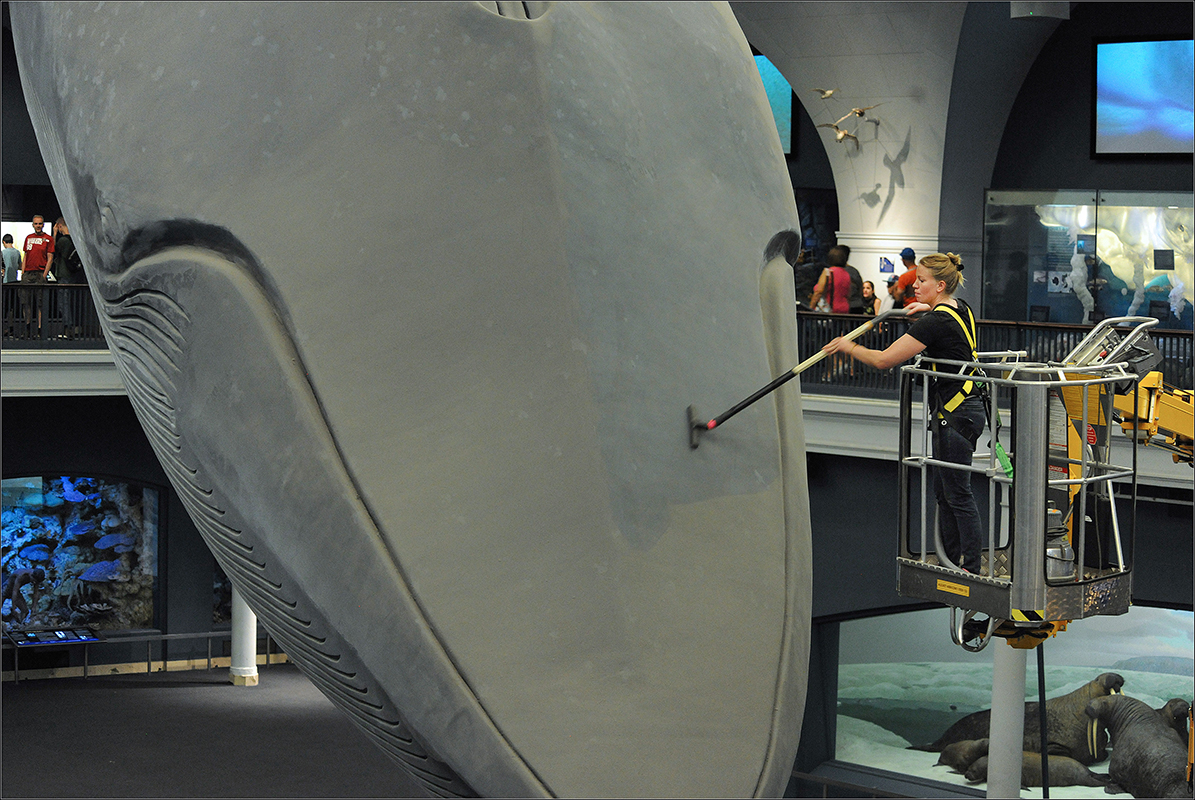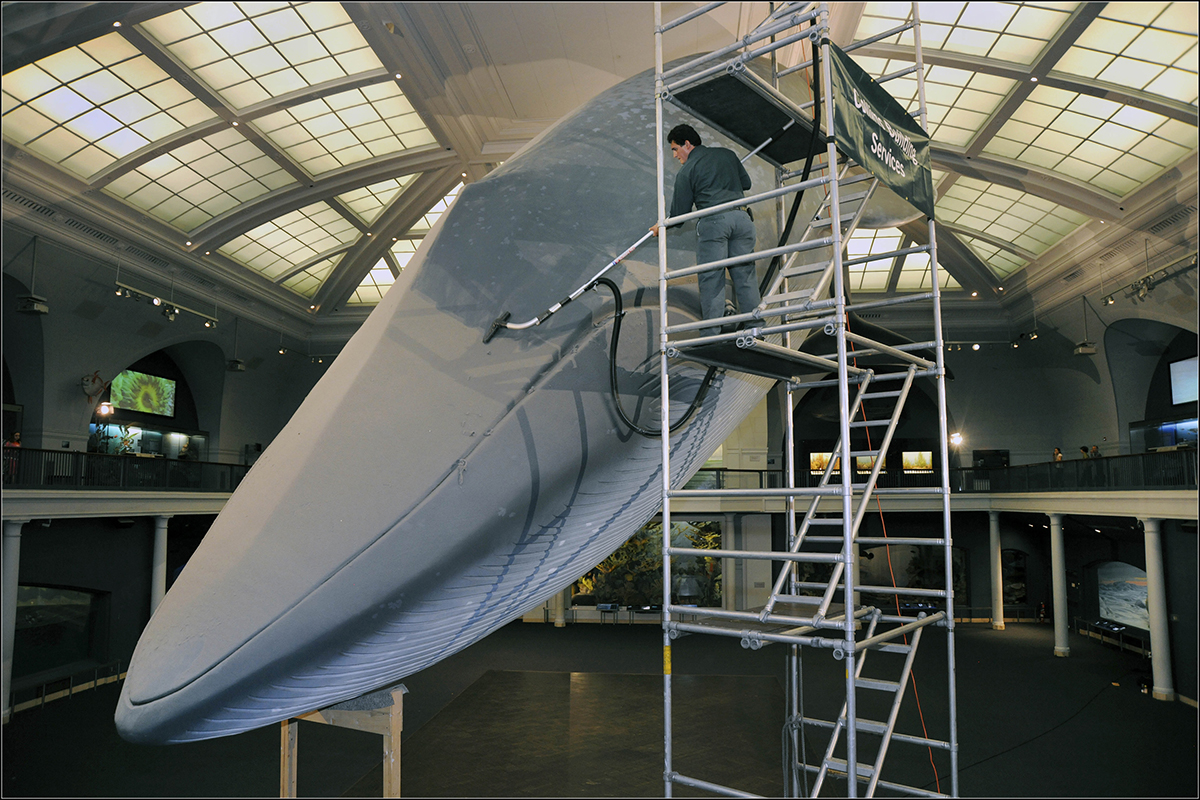How a Museum Cleans a Whale

At the American Museum of Natural History (AMNH) in New York City yesterday (Sept. 7), the well-known blue-whale model that seemingly floats overhead in the Milstein Hall of Ocean Life received its annual two-day "spa" treatment to remove a year's accumulation of dust and grime.
After the cleaning, the whale model, which is 94 feet (29 meters) long and weighs 21,000 pounds (9,525 kilograms), is now dust-free, and its colors are more vibrant. Dappled lights play over its back, simulating the sun's rays on the ocean surface, while the vast space around the model recalls the open ocean — the blue whales' habitat.
Thousands of people watched AMNH's live stream of the cleaning via the museum's Facebook page. [Dangers in the Deep: 10 Scariest Sea Creatures]
Vacuuming a whale
Technophiles hoping to hear about unique and bizarre cleaning accessories will probably be disappointed to find that the whale patrol used a standard vacuum brush to plow through the dirt, as described by Dean Markosian, director of project management for the AMNH Exhibition Department and supervisor of the annual whale cleaning.
"It needs to be a soft bristle attachment that brushes the dust as we vacuum it," Markosian told Live Science. "But there's no special 'whale attachment' that you can buy in a store."
Five or six years ago, the cleaners had ascended via temporary scaffolding, which had to be dismantled and moved around the whale to complete the whale "bath," Markosian explained.
Now, AMNH Exhibition staff members ascend up to whale height in a special lift. Over the course of two days, they vacuumed dust off the whale's back, starting at the tail and working their way down to the tip of its gigantic head.
Get the world’s most fascinating discoveries delivered straight to your inbox.
A long-overdue makeover
The blue whale is an iconic exhibit whose popularity has endured for decades. But in addition to the annual dust removal, this fiberglass model has undergone other dramatic changes in recent years — and so has the Hall of Ocean Life, where it lives. [Iconic Blue Whale at AMNH Gets a Scrubbing]
Revisions to both the whale and the hall — AMNH debuted major updates in a 2003 renovation — reflect evolving views of the world's ocean ecosystems and new perspectives on the many forms of life that inhabit them, said Melanie Stiassny, Axelrod Research Curator for the AMNH Department of Ichthyology.
When the whale was first installed in 1969, people regarded the ocean and the life it contained in a more utilitarian light, which was reflected in the name of the exhibit hall the whale inhabited.
"It used to be known as 'The Hall of Marine Resources,'" Stiassny told Live Science.
This human-centric view gradually gave way to a broader appreciation of the ocean as a complex and dominant system in its own right; remodeling the hall represented an updated understanding of ocean life in general, Stiassny explained.
At the same time, the whale received a long-overdue makeover. The original model was based on measurements taken by AMNH scientists in the 1920s. The measurements were of a dead female blue whale captured by a whaling station in the southern Atlantic, and although the artists who crafted the whale followed the original records, there were anatomical inaccuracies, likely because the whale that the scientists examined was already decaying. [The World's Biggest Beasts: Here and Gone (Photos)]
"It was the wrong color. It had bulging eyes, probably due to decomposition," Stiassny said. In 2001, artists adjusted the body color and flattened the whale's eyes, also adding a navel that had originally been omitted.
Today, the AMNH whale resembles living blue whales more closely than before. However, while scientists' knowledge of blue whales has certainly improved, there is still much about these giants that remains elusive.
"We still don't know how many blue whales are out there," Stiassny said. "We don't know exactly where they go to breed. They still remain one of the great mysteries of the ocean."
And though human understanding of the oceans has also come a long way since the whale model's 1969 debut, blue whales' ocean home remains just as mysterious.
"At the time when we renovated the hall, we knew more about the dark side of the moon than we knew about the ocean," Stiassny said. "In many ways, that's still the case."
Original article on Live Science.

Mindy Weisberger is a science journalist and author of "Rise of the Zombie Bugs: The Surprising Science of Parasitic Mind-Control" (Hopkins Press). She formerly edited for Scholastic and was a channel editor and senior writer for Live Science. She has reported on general science, covering climate change, paleontology, biology and space. Mindy studied film at Columbia University; prior to LS, she produced, wrote and directed media for the American Museum of Natural History in NYC. Her videos about dinosaurs, astrophysics, biodiversity and evolution appear in museums and science centers worldwide, earning awards such as the CINE Golden Eagle and the Communicator Award of Excellence. Her writing has also appeared in Scientific American, The Washington Post, How It Works Magazine and CNN.



